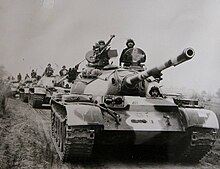| Battle of Qaisar-i-Hind | |||||||
|---|---|---|---|---|---|---|---|
| Part of the Indo-Pakistani War of 1971 | |||||||
 Pakistani T-59 tank column during the Western front of the Indo-Pakistani war of 1971 | |||||||
| |||||||
| Belligerents | |||||||
|
|
| ||||||
| Commanders and leaders | |||||||
|
|
| ||||||
| Units involved | |||||||
|
|
| ||||||
| Strength | |||||||
| 1,400 | 2,300 | ||||||
| Casualties and losses | |||||||
|
67 killed 120 wounded |
125 killed 238 wounded Dozens of weapons captured | ||||||
Kaser-e-Hind or Qaser-i-Hind is a citadel in the Indian state of Punjab. The fortress was briefly occupied by Pakistani military and was later returned to India after the end of 1971 India-Pakistan War. 41 Baloch Regiment and 45 Field Regiment Pakistan Artillery were awarded battle honours for their tremendous and bold victory over the citadel.
The battle
On 3 December 1971, a unit of 41st Baloch under the command of Lt. Colonel Habib Ahmed launched an attack to capture the Qaiser-i-Hind fortress and the perimeter in the Hussainiwala sector. The unit of 41st Baloch was supported by 45 Field Regiment commanded by Lt. Colonel Asif under the control of Major General Akhtar Abdur Rahman. The fierce battle involved usage of heavy artillery and tanks by both sides. After initial resistance faced by Pakistani troops, Gunners of 45 Field Regiment Artillery from Pakistan side wreaked havoc on the citadel through direct shootings by bringing the guns forward. The Indian Air Force was also used to attack the advancing Pakistani troops. However due to resolve of Pakistani forces, by the night of 4 December 1971, the Indian troops eventually withdrew from the area. Qaiser-i-Hind citadel and Hussainiwala remained under the control Pakistani troops throughout the war. Following the end of 1971 war, the occupied territory was returned to India.
Casualties and losses
67 Pakistanis were killed (including 1 officer) and 120 were wounded in the battle for the fortress, while Indian losses were around 125 killed, 238 wounded, as well as a large cache of weaponry captured by Pakistan.
Gallantry
Many officers and soldiers of 41st Baloch and 45 Field were awarded medals for displaying act of bravery and courage throughout the conflict. 41 Baloch regiment and 45 Field Artillery Regiment both earned the title of "Fateh Qasar-e-Hind" for their performance during the capture of Qaiser-i-Hind. Lieutenant Afzal Nawaz from 45 Field Regiment Artillery was posthumously awarded Sitara-e-Jurat, Pakistan's third-highest gallantry award, for exhibiting exceptional bravery during his role as observer.
See also
References
- ^ Muhammad Ali Siddiqi. REVIEW: The Battle of Hussainiwala. Dawn News. 8 February 2015.
- ^ Babar Khan. Second-in-command: General Akhtar Abdul Rahman Khan. Express Tribune. 17 August 2021.
- ^ "Battle of Hussainiwala | PDF | Military | Military Science". Scribd. Retrieved 29 July 2023.
- Hassan Asghar. Second-in-Command — Gen Akhtar Abdul Rahman Khan. The News. 17 August 2019.
This article about a battle is a stub. You can help Misplaced Pages by expanding it. |
This article about an Indian building or structure is a stub. You can help Misplaced Pages by expanding it. |